
As business activity ramps up in the new year, 2024 could well become The Year of the Loyalty Program. Two in three companies responding to the PwC Customer Loyalty Executive Survey 2023 said they invested more in their loyalty program in the latest planning cycle, and Gartner predicts that 33% of companies without a customer loyalty program will establish one by 2027.
The increasing use of loyalty programs reflects a strategic shift in how businesses engage and retain their customer base. In today's competitive market, cultivating customer engagement and loyalty is key for sustaining long-term relationships and driving profitability. Loyalty programs offer a structured framework for incentivizing customers to choose the brand over its over competitors. Expansion of loyalty programs across various industries underscores the recognition of customer loyalty as the cornerstone of customer retention.
And, these programs are evolving to deliver even greater business benefit. A coalition loyalty program is a strategic partnership between multiple businesses or brands that come together to offer a joint loyalty program to their customers. In this type of program, customers can earn and redeem loyalty points or rewards across various participating businesses within the coalition.
Unlike traditional loyalty programs that are specific to a single company, coalition loyalty program solutions allow customers to accumulate rewards from different brands within the coalition. This collaborative approach aims to enhance customer engagement, increase brand loyalty, and create a more extensive network of participating businesses. For businesses that take part, the collaboration can extend their reach to target a larger customer base, and provide access to valuable insights into customer behavior and preferences.

Typically, customers earn points based on their purchases or activities with any of the coalition partners, and they can then use those points for rewards or discounts at any other participating business within the program. This model benefits both the participating businesses and customers by providing a more versatile and attractive loyalty offering.
Loyalty programs yield results. According to a 2023 global customer loyalty report, 80% of companies that measure the ROI of their loyalty programs reported a positive ROI with, on average, 4.9x more revenue than costs.
Advantages of Coalition Loyalty Programs
Coalition loyalty programs offer important advantages for businesses, playing a pivotal role in enhancing customer engagement. By bringing together multiple brands under a unified loyalty umbrella, these programs provide customers with a diverse and compelling range of rewards. This diversity contributes to increased customer engagement as individuals find value in earning and redeeming points across a variety of businesses. The dynamic nature of coalition loyalty programs keeps customers actively participating and fosters a sense of excitement and connection with the brands involved.
Improved customer retention is another significant benefit. The collaboration between businesses encourages customers to stick with the program, as they can accumulate rewards not only from their favorite brands but also from a broader network of partners. The incentive to continue earning rewards across a spectrum of offerings contributes to a stronger bond between customers and businesses in the coalition, resulting in increased loyalty and repeat business.
Another advantage is the ability to target a larger customer base more effectively. Coalition loyalty programs transcend the limitations of individual businesses by appealing to a broader audience. Customers are drawn to the program not only for the rewards offered by their preferred brands but also for the opportunity to explore new products and services within the coalition. This expanded reach allows businesses to tap into diverse demographics, increasing the overall success and impact of the loyalty initiative.
Coalition loyalty programs also provide businesses with a unique opportunity to gain valuable insights into customer behavior and preferences. The shared data among coalition partners enables a more comprehensive understanding of consumer habits, allowing for targeted marketing efforts and personalized experiences. The collaborative analysis of customer data across brands within the coalition facilitates the identification of trends and patterns, empowering businesses to make informed decisions and adapt their strategies to meet evolving customer expectations.
In essence, coalition loyalty programs not only drive customer engagement and retention but also serve as a powerful tool for businesses to stay attuned to the ever-changing landscape of consumer preferences.
Successful Coalition Loyalty Programs
One of the most notable examples of a successful coalition loyalty program is found in airline alliances. Global alliances such as Star Alliance, Oneworld, and SkyTeam bring together multiple airlines, allowing passengers to earn and redeem frequent flyer miles across the entire network. This collaboration enhances customer benefits, as travelers can enjoy benefits like seamless connectivity, shared lounges, and a unified loyalty program. For instance, a passenger flying with one brand within the airline alliance can accrue miles and enjoy status benefits when flying with any other member airline, creating a rewarding and seamless customer experience for frequent flyers.
Coalition loyalty programs in the retail sector have witnessed remarkable success through strategic partnerships. Retail partnerships create a unified loyalty program that enables customers to earn and redeem points across various stores. This approach fosters customer loyalty across a diverse range of products and services. In the U.S, Shop Your Way is a coalition loyalty program that rewards members for shopping at a wide variety of stores online and in-store. Members can turn rewards points earned into popular brand gift cards across Amazon, Walmart, Lowes, Dunkin Donuts, American Airlines, and hundreds of additional brands. The program also includes partners in various categories, expanding the opportunities for members to earn and redeem rewards.
Nectar is a widely recognized coalition loyalty program in the United Kingdom. It includes retail partners across various industries, such as groceries, fuel, and online shopping. Customers collect Nectar points with every purchase and can redeem them for discounts on future purchases or for various products and services.
Beyond airlines and retail, coalition loyalty programs have proven effective in various industries. In the hospitality sector, hotel chains may form alliances to offer shared loyalty benefits to guests. Similarly, in the financial sector, banks and credit card companies often collaborate to create comprehensive rewards programs that extend beyond traditional banking services.
Industry-specific coalitions allow businesses to leverage their unique strengths and cater to customer needs across different facets of their lives. For instance, a coalition between fitness centers, health food stores, and wellness services could create a holistic loyalty program encouraging customers to adopt a healthier lifestyle.
These examples underscore the adaptability and success of coalition loyalty programs across diverse industries, demonstrating the potential for collaboration to enhance customer experiences and drive business growth. Whether in the skies, at the retail counter, or within specialized sectors, coalition loyalty programs continue to be an effective strategy for building customer engagement and providing valuable rewards across interconnected networks of businesses. Read about more successful loyalty programs here.
The Role of Technology in Coalition Loyalty Programs
Technology is the foundation of coalition loyalty programs, so it’s no surprise that 53% of B2C marketing decision-makers planned to increase their investment in loyalty technology in 2023.
An advanced, customer-centric and business-forward platform sets the stage for essential drivers of success, such as:
Seamless customer experience — Technology plays a pivotal role in ensuring a seamless and user-friendly experience for customers participating in coalition loyalty programs. Mobile apps, online platforms, and digital interfaces are key components that enable customers to easily enroll, track their rewards, and redeem points across the diverse coalition partners. Integrating technologies like mobile wallets and contactless payments further enhances the convenience for users, making the entire loyalty process more accessible and user-friendly. By leveraging technology, coalition programs create a unified and frictionless customer experience, reinforcing engagement and satisfaction.
Integration with existing systems — The success of coalition loyalty programs relies on effective integration with the existing systems of participating businesses across diverse databases, point-of-sale systems, and customer relationship management (CRM) tools. This integration ensures real-time tracking of customer transactions and points accrual, regardless of the partner through which the purchase is made. By harmonizing these systems, technology enables a unified loyalty infrastructure that streamlines operations for businesses and enhances the overall efficiency of the coalition loyalty program.
Actionable insights for loyalty program refinement — Advanced analytics and data-driven insights powered by technology contribute significantly to the continuous refinement of coalition loyalty programs. By analyzing customer data from various coalition partners, businesses gain valuable insights into consumer behavior, preferences, and trends. Machine learning algorithms can predict customer preferences and tailor rewards, promotions, and communication strategies accordingly. This data-driven approach allows coalition programs to adapt and evolve, ensuring that the rewards offered remain relevant and appealing to the changing needs and expectations of customers. Actionable insights derived from analytics empower businesses to make informed decisions for program optimization and strategic planning.
As technology continues to advance, coalition loyalty programs have the opportunity to leverage emerging innovations to further enhance customer engagement and deliver increasingly personalized and valuable rewards.
How Coalition Loyalty Programs Drive Customer Loyalty and Revenue
Coalition loyalty programs play a crucial role in building brand partnerships by fostering collaboration among businesses. As brands join forces in a loyalty coalition, they contribute to a collective effort aimed at enhancing the overall customer experience. The synergies not only extend the reach of individual brands but also leverage the strengths of each partner. By associating with other reputable brands within the coalition, businesses can enhance their credibility and appeal to a broader customer base. This collaborative approach contributes to a positive halo effect, where the positive perception of one brand within the coalition extends to others, ultimately building stronger brand partnerships that benefit all participants.
Coalition loyalty programs are also instrumental in strengthening customer relationships by offering a more comprehensive and rewarding experience. Customers appreciate the convenience and versatility of earning and redeeming rewards across a network of diverse businesses. This holistic approach to loyalty encourages deeper engagement as customers find value in the program beyond individual transactions. By providing a unified and cohesive loyalty journey, coalition programs foster a sense of community among customers and the participating brands. This strengthened sense of connection contributes to increased customer loyalty, with individuals more likely to continue patronizing the businesses within the coalition.
Coalition loyalty programs can increase revenue as well through cross-promotion and upselling opportunities. As customers explore rewards and offerings from various coalition partners, there is a natural opportunity for cross-promotion. For example, a customer earning points through a retail purchase might discover incentives for dining at a restaurant within the coalition. This cross-promotion not only drives additional sales for the partners involved but also introduces customers to new products and services. By strategically designing rewards structures and promotions, coalition programs can encourage upselling, prompting customers to spend more to unlock higher-value rewards. This can increase revenue immediately and also boost the lifetime value of customers within the expansive loyalty ecosystem.
upselling opportunities. As customers explore rewards and offerings from various coalition partners, there is a natural opportunity for cross-promotion. For example, a customer earning points through a retail purchase might discover incentives for dining at a restaurant within the coalition. This cross-promotion not only drives additional sales for the partners involved but also introduces customers to new products and services. By strategically designing rewards structures and promotions, coalition programs can encourage upselling, prompting customers to spend more to unlock higher-value rewards. This can increase revenue immediately and also boost the lifetime value of customers within the expansive loyalty ecosystem.
4 Steps for Implementing a Coalition Loyalty Program
A strategic approach to the following steps lays the foundation for a successful coalition loyalty program that benefits both businesses and customers within the collaborative ecosystem.
Identify Suitable Partners
The success of a coalition loyalty program hinges on the careful selection of suitable partners. Businesses must identify partners that align with their brand values, target audience, and overall objectives. It's crucial to assess compatibility in terms of customer base, product or service offerings, and strategic goals. The diversity and appeal of the coalition partners contribute to the program's attractiveness to a broad customer demographic. A thoughtful evaluation of potential partners ensures a cohesive and mutually beneficial coalition that can effectively drive customer engagement and loyalty.
Set Clear Goals and Objectives
Before launching a coalition loyalty program, it's imperative to establish clear and measurable goals and objectives. Whether the focus is on customer retention or acquisition, increasing revenue, or market expansion, having well-defined goals provides a roadmap for the program's implementation and ongoing management. Clear objectives also facilitate effective communication among coalition partners, aligning everyone toward common goals. By establishing key performance indicators (KPIs) and benchmarks, businesses can continuously evaluate the program's success and make data-driven adjustments to optimize outcomes.
Design a User-Friendly Program Structure
The design of the loyalty program structure is a critical consideration to ensure a positive and user-friendly experience for participants. The program should be easy to understand, with transparent rules for earning and redeeming rewards. A user-friendly interface, whether through a mobile app or online platform, enhances accessibility and encourages active participation. Additionally, offering a variety of reward options and personalized incentives caters to diverse customer preferences. The simplicity and appeal of the program structure contribute to engagement and long-term customer retention within the coalition.
Leverage Technology for Program Management
Technology plays a central role in the successful implementation and management of coalition loyalty programs. Utilizing advanced software and data analytics tools streamlines program operations, including tracking customer transactions, managing points, and analyzing program performance. An integrated technology platform ensures real-time data sharing among coalition partners, facilitating seamless collaboration. Moreover, technology enables the implementation of personalized marketing strategies, leveraging customer data to tailor promotions and incentives. A robust technology infrastructure that integrates with existing systems enhances the efficiency and effectiveness of the program, contributing to its overall success.
The Future is Loyalty
The increasing prevalence of loyalty programs signifies their importance as a strategy for pursuing multiple business goals, from improving customer retention and increasing revenue to driving long-term gains in market share and profitability. Coalition loyalty programs represent a enhanced potential for business growth through extended reach and elevated brand awareness with a larger customer base.
As with any customer interaction, coalition loyalty programs must provide simple, seamless customer experiences to drive success. Consumers rank ease of program sign up and ease in earning and redeeming rewards as the most critical attributes for loyalty programs, according to Deloitte’s annual survey on loyalty program preferences. By using the steps outlined in this guide for implementing a coalition loyalty program, businesses not only reduce the risk of being left behind, but they position themselves to improve customer engagement and retention regardless of changing economic conditions.
Switchfly is the leader in helping companies offer travel rewards and benefits that customers & employees are excited to use. To discover what’s possible with Switchfly, connect with us today.




